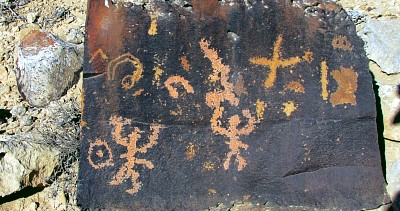
Fish and the Journey to the Afterlife
The fish in Negev Desert rock art is far from a simple depiction of aquatic life. Its presence is remarkable given the total absence of water in the arid desert landscape. Instead, it holds profound mythological meaning, symbolizing a sacred, imaginary guide moving through the dark waters of the underworld—a psychopomp leading the soul toward renewal. In this ancient worldview, death was not an end but a transition. Like the motifs of ships and birds, the fish embodied the soul’s passage and the trials encountered on its way to the afterlife (Golan 1991).
Cosmic Waters and the Underworld
Many ancient cultures conceived of the universe as a layered cosmos, with waters not only above the heavens but also beneath the earth. These “lower waters” were thought to sustain life while simultaneously concealing the entrance to the underworld—a place of both origin and return. In Sumerian cosmology, the earth floated on a vast subterranean ocean known as the Apsû, ruled by the god Enki (Ea), who controlled the life-giving and destructive powers of the deep. From this hidden realm, the forces of fertility, wisdom, and creation were believed to rise, while the souls of the dead descended back into its dark expanse.
A similar duality appeared in Egyptian thought, where the Nun, the primeval water beneath the earth, was both the source of creation and the route of the sun god’s nightly journey through the underworld. Each night, Ra sailed across these subterranean waters, battling serpents like Apophis before emerging reborn at dawn. In Greek and Near Eastern traditions alike, subterranean rivers such as the Styx or Oceanus encircled the world, marking the boundary between the realms of the living and the dead.
Against this mythological background, the Negev Desert engravings take on a deeper meaning. The fish and ship motifs reflect not a physical landscape but a cosmological one—an imagined sea beneath the desert’s surface, the dark waterway through which the soul must travel after death. These images echo a universal ancient belief: that beneath the visible world lies a hidden ocean connecting life, death, and rebirth.
Vessels of Souls
In early rock art, various means of transport symbolize the psychopomp’s function. In Fig. 1, the inverted ship represents the voyage through the underworld, while the vertical lines depict souls embarking on their passage. Similar imagery appears in Aegean and Cycladic art, where ships drawn by fish are attacked by serpents—emblems of chaos opposing the voyage to light (Salimbeti 2014).

The Fish as a Psychopomp
In the Negev Desert engravings (Figs. 2–3), the fish assumes the central role of soul-carrier. In Fig. 2, the fish (3) bears the souls shown as vertical strokes (2), while a natural crack in the rock (4) marks the symbolic boundary between life and the underworld. Above them, a tri-fingered symbol (1), derived from a bird’s foot, represents the celestial messenger descending to guide additional souls (Kristiansen 2018).

Fig. 3 depicts a related scene. A serpent (1) coils around the sun (2), seeking to obstruct its passage, while a fish (4) carries souls upon its back (3). This imagery echoes the Egyptian myth of Ra’s nocturnal voyage through the underworld, guided by the sacred fish Abtu, whose task was to warn the sun god’s boat of the serpent Apophis, the force of chaos that sought to halt the sun’s rebirth. The Negev engraving distills this cosmic drama into a single, vivid composition—a timeless struggle between light and darkness, death and renewal, and the enduring triumph of life.

Conclusion
The fish motif in Negev Desert rock art captures, in a single glance, an ancient vision of the soul’s journey through the hidden waters of the underworld. The image of fish swimming across a barren, waterless landscape defies the desert’s reality and transports the viewer into a mythic realm. By linking the waters of earth and sky, the fish became a symbol of passage and renewal, a bridge between life and death (Eliade 1959; Hornung 1999).
This motif’s uniqueness lies in its shared yet distinct expression within both Egyptian and Negev traditions. In Egypt, the sacred fish Abtu guided Ra’s solar barque through the perilous waters of the underworld, warning him of the serpent Apophis, the embodiment of chaos (Hornung 1999; Wilkinson 2003). In the Negev engravings, the fish bears souls upon its back, leading them through the dark waters toward rebirth, repeating the same ancient idea of life renewal (Golan 1991; Kristiansen 2018).
Related reading
Bibliography
Eliade, M. 1959. The Sacred and the Profane: The Nature of Religion. New York: Harcourt Brace.
Golan, A. 1991. Myth and Symbol: Symbolism in Prehistoric Religions. Jerusalem: Magnes Press.
Hornung, E. 1999. The Ancient Egyptian Books of the Afterlife. Ithaca: Cornell University Press.
Kristiansen, K. 2018. “The Winged Triad in Bronze Age Symbolism: Birds and Their Feet.”
Salimbeti, A. 2014. “The Greek Age of Bronze — Ship.”
Wilkinson, R. H. 2003. The Complete Gods and Goddesses of Ancient Egypt. London: Thames & Hudson.
© All rights reserved. This material may not be published, broadcast, rewritten, or redistributed in whole or in part without the express written permission of negevrockart.co.il
Yehuda Rotblum
